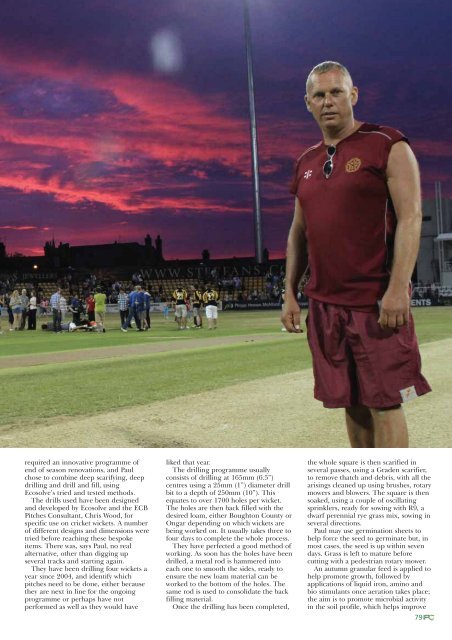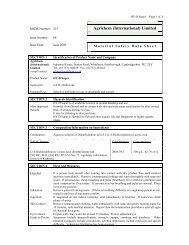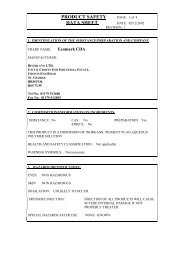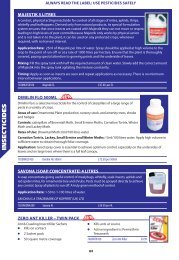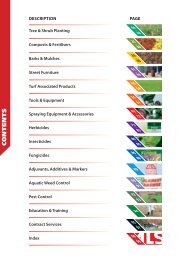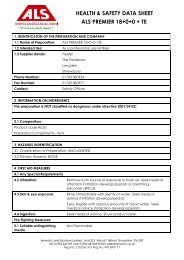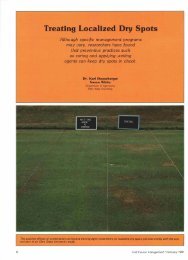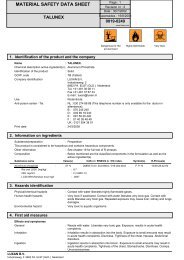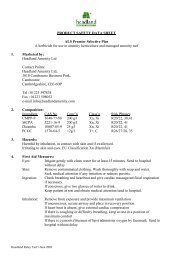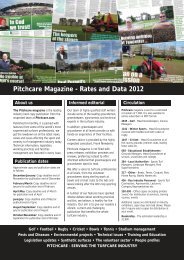Marshalling his troops - Pitchcare
Marshalling his troops - Pitchcare
Marshalling his troops - Pitchcare
Create successful ePaper yourself
Turn your PDF publications into a flip-book with our unique Google optimized e-Paper software.
equired an innovative programme of<br />
end of season renovations, and Paul<br />
chose to combine deep scarifying, deep<br />
drilling and drill and fill, using<br />
Ecosolve’s tried and tested methods.<br />
The drills used have been designed<br />
and developed by Ecosolve and the ECB<br />
Pitches Consultant, Chris Wood, for<br />
specific use on cricket wickets. A number<br />
of different designs and dimensions were<br />
tried before reaching these bespoke<br />
items. There was, says Paul, no real<br />
alternative, other than digging up<br />
several tracks and starting again.<br />
They have been drilling four wickets a<br />
year since 2004, and identify which<br />
pitches need to be done, either because<br />
they are next in line for the ongoing<br />
programme or perhaps have not<br />
performed as well as they would have<br />
liked that year.<br />
The drilling programme usually<br />
consists of drilling at 165mm (6.5”)<br />
centres using a 25mm (1”) diameter drill<br />
bit to a depth of 250mm (10”). T<strong>his</strong><br />
equates to over 1700 holes per wicket.<br />
The holes are then back filled with the<br />
desired loam, either Boughton County or<br />
Ongar depending on which wickets are<br />
being worked on. It usually takes three to<br />
four days to complete the whole process.<br />
They have perfected a good method of<br />
working. As soon has the holes have been<br />
drilled, a metal rod is hammered into<br />
each one to smooth the sides, ready to<br />
ensure the new loam material can be<br />
worked to the bottom of the holes. The<br />
same rod is used to consolidate the back<br />
filling material.<br />
Once the drilling has been completed,<br />
the whole square is then scarified in<br />
several passes, using a Graden scarifier,<br />
to remove thatch and debris, with all the<br />
arisings cleaned up using brushes, rotary<br />
mowers and blowers. The square is then<br />
soaked, using a couple of oscillating<br />
sprinklers, ready for sowing with R9, a<br />
dwarf perennial rye grass mix, sowing in<br />
several directions.<br />
Paul may use germination sheets to<br />
help force the seed to germinate but, in<br />
most cases, the seed is up within seven<br />
days. Grass is left to mature before<br />
cutting with a pedestrian rotary mower.<br />
An autumn granular feed is applied to<br />
help promote growth, followed by<br />
applications of liquid iron, amino and<br />
bio stimulants once aeration takes place;<br />
the aim is to promote microbial activity<br />
in the soil profile, which helps improve<br />
79


